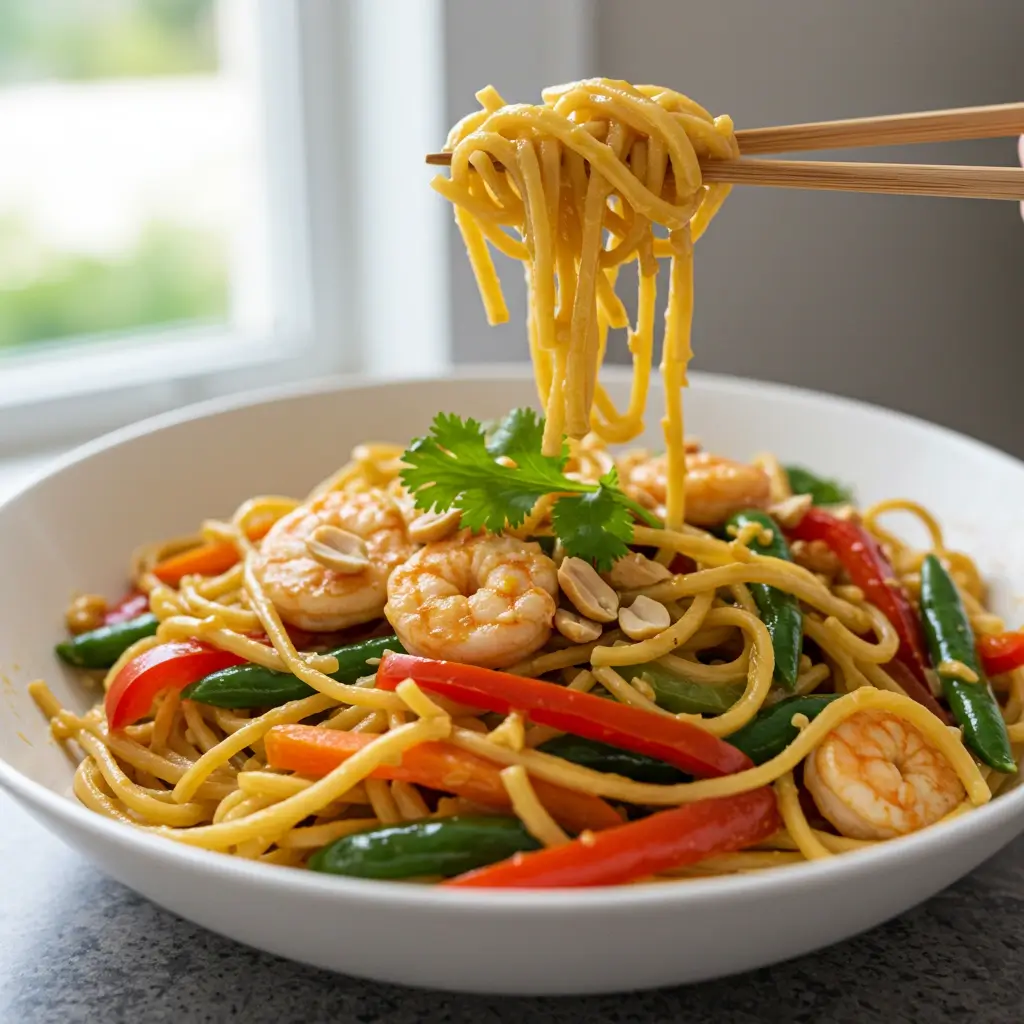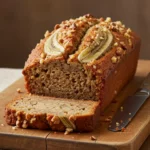If you’re on the hunt for a quick, flavorful, and nutritious meal that doesn’t require a mountain of dishes, look no further than One-Pot Thai Peanut Noodles. This dish is a delightful fusion of flavors that brings the vibrant taste of Thailand to your kitchen with minimal effort. Whether you’re a busy professional, a parent juggling multiple responsibilities, or simply someone who loves good food, this recipe is a game-changer.
The creamy peanut sauce, infused with garlic, ginger, soy sauce, and a hint of sweetness, perfectly coats the noodles, creating a symphony of taste in every bite. Tossed with crunchy vegetables like carrots, bell peppers, and snap peas, and topped with crushed peanuts and fresh cilantro, this dish strikes the perfect balance between indulgent and healthy. The best part? Everything cooks in one pot, saving you precious time on cleanup.
This versatile recipe is easily customizable. Add tofu, chicken, or shrimp for protein, or swap in your favorite vegetables to suit your taste. Whether you’re whipping it up for a weekday dinner or impressing guests with its restaurant-quality flavor, One-Pot Thai Peanut Noodles are sure to become a staple in your recipe rotation. Enjoy a delicious, hassle-free meal in under 30 minutes!
Ingredients
Creating a delicious meal starts with the right ingredients. Here’s what you’ll need for this tasty dish:
- 8 oz rice noodles: The perfect base for soaking up all the delicious flavors.
- 1 cup vegetable broth: Adds depth and richness to the dish.
- 1/4 cup peanut butter: Provides creaminess and that classic Thai peanut flavor.
- 3 tbsp soy sauce: Enhances the umami and adds saltiness.
- 2 tbsp maple syrup: Brings a subtle sweetness that balances the flavors.
- 1 tbsp lime juice: Adds a touch of acidity and freshness.
- 1 tsp garlic powder: Infuses the dish with aromatic flavor.
- 1 cup mixed veggies: We suggest bell peppers and carrots for color and crunch.
- 1/4 cup chopped peanuts for garnish: Offers a satisfying crunch and extra peanut flavor.
- Fresh cilantro for garnish: Adds a fresh, herbal note to finish the dish.
Instructions
This one-pot recipe is as straightforward as it is delicious. Follow these simple steps to create your own Thai peanut noodles:
- Boil the Broth: In a large pot, bring the vegetable broth to a boil. This will serve as the flavorful base for your noodles.
- Cook the Noodles: Add rice noodles to the boiling broth and cook for 4-5 minutes or until they are tender. Stir occasionally to prevent sticking.
- Create the Sauce: Stir in the peanut butter, soy sauce, maple syrup, lime juice, and garlic powder. Mix well until the peanut butter is fully melted and the sauce is smooth.
- Add the Veggies: Toss in the mixed veggies and cook for another 2-3 minutes until they are heated through but still crisp.
- Serve: Dish out the noodles hot and finish with chopped peanuts and fresh cilantro for that extra burst of flavor and texture.
Nutrition Facts
Eating well doesn’t have to mean sacrificing flavor. This dish is both satisfying and nutritious. Here’s a breakdown of the nutritional content per serving:
- Calories: 320
- Protein: 10g
- Fat: 15g
- Carbohydrates: 40g
- Fiber: 3g
These numbers reflect a balance of macronutrients that provide energy and keep you feeling full.
How to Serve
Presentation can transform a simple dish into a feast for the eyes. Serving your Thai peanut noodles with care and attention to detail elevates the dining experience and makes it more enjoyable for your guests. Here are some expanded serving suggestions to enhance your presentation and bring out the best in your dish:
Use a Large Bowl
Opt for a large, deep bowl when serving Thai peanut noodles. The generous size does more than just accommodate the ingredients; it allows for an inviting presentation that encourages sharing and interaction. A bowl with a wide rim can also provide a canvas for garnishes, making the dish appear even more appealing. Consider using a bowl with a unique design or color that contrasts with the vibrant hues of the noodles and toppings, enhancing visual interest. Additionally, the depth of the bowl makes it easier for diners to mix the noodles and sauce thoroughly, ensuring that every bite is packed with flavor.
Top with Fresh Garnishes
Garnishing is a key step in serving Thai peanut noodles. After plating the noodles, take the time to sprinkle a generous amount of chopped peanuts over the top. The crunchy texture of the peanuts adds a delightful contrast to the softness of the noodles. Fresh cilantro is another essential garnish; its bright green color and aromatic flavor bring a burst of freshness that complements the richness of the peanut sauce. For an extra pop of color, consider adding thinly sliced red chili or a few sprigs of Thai basil. Edible flowers or microgreens can also be used for a sophisticated touch, transforming your dish into a visually stunning centerpiece. Finally, a squeeze of lime juice right before serving can enhance the dish’s flavors and add a zesty finish.
Pair with a Light Drink
The right beverage can elevate your meal, balancing the rich and savory flavors of the Thai peanut noodles. Consider pairing the dish with a refreshing drink that complements its taste profile. Iced green tea is an excellent choice; its subtle earthy notes and slight bitterness create a lovely contrast to the sweetness of the peanut sauce. For a more vibrant option, citrus-infused water can be a great accompaniment. Simply infuse water with slices of lemon, lime, or orange, and perhaps a few sprigs of mint, to create a refreshing beverage that cleanses the palate. Alternatively, a light sparkling water with a splash of fruit juice can add a delightful fizz that enhances the overall dining experience. If you’re looking for something a bit more indulgent, a light white wine or a fruity cocktail can also complement the dish beautifully.
Final Touches
To further enhance the dining experience, consider setting the table with care. Use colorful plates that reflect the vibrant nature of the dish, and don’t forget to include utensils that match the theme of your meal. Cloth napkins can add a touch of elegance, while bamboo or wooden serving utensils can evoke the essence of Thai cuisine. Dim the lights slightly or add candles to create a warm, inviting atmosphere that encourages your guests to linger over their meal.
Incorporating these serving suggestions will not only make your Thai peanut noodles visually appealing but also create a pleasurable dining experience that highlights the flavors and textures of the dish. Enjoy the process of serving as much as you enjoy cooking, and your guests will surely appreciate the extra effort.
Additional Tips for Perfect Thai Peanut Noodles
To ensure your Thai peanut noodles are the best they can be, consider these additional tips:
Adjust the Spice
If you enjoy a touch of heat in your dishes, don’t hesitate to customize the spice level of your sauce. Start by adding a small dash of sriracha, a popular Thai chili sauce known for its tangy flavor and moderate heat. If you prefer a more subtle spice, incorporate a pinch of red pepper flakes directly into the sauce to achieve a gentle warmth without overwhelming the other flavors. For those who want to dial up the heat even further, consider using fresh sliced Thai chilies or a few drops of chili oil, which can enhance the dish with a rich, smoky flavor. Remember to taste as you go; you can always add more spice, but it’s challenging to tone it down once it’s in the mix!
Swap the Veggies
One of the great aspects of Thai peanut noodles is their versatility, allowing you to personalize the dish according to your preferences and what you have on hand. While bell peppers, carrots, and cucumbers are traditional choices, feel free to get creative! Broccoli florets add a hearty crunch and absorb the delicious peanut sauce beautifully. Snap peas lend a sweet, crisp texture that complements the noodles nicely. Zucchini, when spiralized or sliced thinly, can provide a refreshing, light element. Other vegetables worth considering include baby corn, bok choy, or even shredded cabbage for added crunch. Don’t shy away from seasonal produce either; this dish is an excellent opportunity to use up any leftover vegetables in your fridge!
Make it Gluten-Free
For those following a gluten-free diet, it’s essential to check the ingredients of your soy sauce. Many brands contain wheat, which can be problematic. To ensure your dish remains gluten-free, opt for a gluten-free soy sauce or tamari, which is a Japanese alternative made without wheat. Tamari often has a richer, more complex flavor that can elevate your dish. Additionally, be mindful of your noodle choice—most rice noodles are naturally gluten-free, but always check the packaging to confirm. This small adjustment allows everyone to enjoy the deliciousness of Thai peanut noodles without compromising their dietary needs.
Add Protein
For a satisfying and well-rounded meal, consider adding a source of protein to your Thai peanut noodles. Tofu is a fantastic option, as it absorbs the flavors of the sauce beautifully while providing a plant-based protein source. To prepare tofu, press it to remove excess moisture, then cut it into cubes and sauté until golden brown. Alternatively, cooked chicken can add heartiness and richness to the dish. Simply shred or cube pre-cooked chicken breast or thighs and toss it into the noodles. For a more unique protein addition, try shrimp or even chickpeas for a vegetarian twist. The key is to balance the flavors and ensure your protein complements the creamy, nutty sauce.
Experiment with Garnishes
Don’t underestimate the power of garnishes to elevate your dish! Fresh herbs like cilantro or Thai basil can add a burst of freshness and aromatic flavor. A sprinkle of chopped peanuts not only adds a delightful crunch but also enhances the peanut flavor inherent in the dish. Lime wedges served on the side can provide a zesty kick, brightening up the meal with their acidity. Additionally, consider including sesame seeds for an added layer of texture and a nutty flavor. These finishing touches can transform your Thai peanut noodles from simple to spectacular!
By incorporating these tips, you can create a dish that is not only delicious but also tailored to your taste preferences and dietary needs. Enjoy the process of experimenting with flavors and textures, and don’t forget to share your creations with friends and family for a delightful dining experience!
FAQs
Can I use other types of noodles?
Absolutely! While rice noodles are traditional and gluten-free, you can use any noodle you prefer, such as soba or whole wheat spaghetti.
How can I store leftovers?
Store any leftovers in an airtight container in the refrigerator for up to three days. Reheat gently in a pot with a splash of vegetable broth to maintain moisture.
Is this dish vegan?
Yes, this Thai peanut noodle recipe is entirely plant-based and vegan-friendly.
Can I make this dish nut-free?
If you have a nut allergy, try using sunflower seed butter in place of peanut butter and omit the chopped peanut garnish.
Conclusion
One-Pot Thai Peanut Noodles prove that creating a flavorful and satisfying meal doesn’t have to be complicated or time-consuming. This dish combines the bold, rich flavors of Thai cuisine with the convenience of minimal cleanup, making it ideal for busy weeknights or relaxed weekends. The creamy peanut sauce, with its perfect balance of savory, sweet, and tangy notes, coats the noodles and pairs beautifully with the crisp texture of fresh vegetables like carrots, bell peppers, and snap peas. It’s a one-pot wonder that delivers on taste, nutrition, and simplicity.
What makes this recipe even better is its adaptability. You can easily customize it to suit your preferences or dietary needs. Add a protein like grilled chicken, tofu, or shrimp to elevate it further, or experiment with different vegetables for a new twist each time. Garnished with crunchy peanuts and fresh cilantro, this dish looks as good as it tastes, making it perfect for family dinners or even casual gatherings.
Whether you’re cooking for yourself, your family, or entertaining guests, One-Pot Thai Peanut Noodles are a reliable, crowd-pleasing option. With minimal prep and cleanup, you’ll have more time to relax and savor every bite of this delicious, homemade meal. Enjoy!
Print
One-Pot Thai Peanut Noodles Recipe
Ingredients
- 8 oz rice noodles: The perfect base for soaking up all the delicious flavors.
- 1 cup vegetable broth: Adds depth and richness to the dish.
- 1/4 cup peanut butter: Provides creaminess and that classic Thai peanut flavor.
- 3 tbsp soy sauce: Enhances the umami and adds saltiness.
- 2 tbsp maple syrup: Brings a subtle sweetness that balances the flavors.
- 1 tbsp lime juice: Adds a touch of acidity and freshness.
- 1 tsp garlic powder: Infuses the dish with aromatic flavor.
- 1 cup mixed veggies: We suggest bell peppers and carrots for color and crunch.
- 1/4 cup chopped peanuts for garnish: Offers a satisfying crunch and extra peanut flavor.
- Fresh cilantro for garnish: Adds a fresh, herbal note to finish the dish.
Instructions
- Boil the Broth: In a large pot, bring the vegetable broth to a boil. This will serve as the flavorful base for your noodles.
- Cook the Noodles: Add rice noodles to the boiling broth and cook for 4-5 minutes or until they are tender. Stir occasionally to prevent sticking.
- Create the Sauce: Stir in the peanut butter, soy sauce, maple syrup, lime juice, and garlic powder. Mix well until the peanut butter is fully melted and the sauce is smooth.
- Add the Veggies: Toss in the mixed veggies and cook for another 2-3 minutes until they are heated through but still crisp.
- Serve: Dish out the noodles hot and finish with chopped peanuts and fresh cilantro for that extra burst of flavor and texture.
Nutrition
- Serving Size: One Normal Portion
- Calories: 320
- Fat: 15g
- Carbohydrates: 40g
- Fiber: 3g
- Protein: 10g





